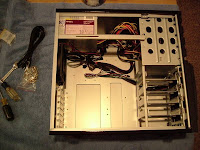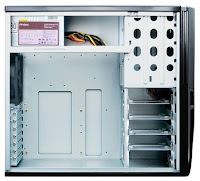The Sonata III 500 is supposed to be one of the quietest computer cases on the planet, advertised by Sonata as "whisper quiet when it comes to system noise."
 This is why I bought it, but frankly, I don't see what all the fuss is about. Here is what the Sonata III 500 does have for noise reduction:
This is why I bought it, but frankly, I don't see what all the fuss is about. Here is what the Sonata III 500 does have for noise reduction:- An efficient 500-watt power supply with its own "low noise" cooling fan. I haven't powered it up yet, so I can't yet testify to the lack of noise but I expect it to be quiet,
- A normal-looking three-speed 120 mm rear exhaust fan. I was unable to find noise ratings published by Antec, but I expect it to be quiet at the lower speeds and noisy at the top speed,
- Silicone grommets for mounting the hard drives, to absorb noise and vibrations, and
- Rubber feet.
 On the flip side, though, here is what the Sonata does not have:
On the flip side, though, here is what the Sonata does not have:- Sound-deadening panels or foam of any kind to absorb sound or prevent conduction through the hard steel panels,
- Baffling to prevent sound generated inside from coming out either the front or back air ports,
- Gaskets or sealant to prevent sound from coming through the various cracks, such as around the side and front doors, or
- Joint treatment to prevent the doors from rattling.
 Air Cooling:
Air Cooling:The air filter is built-in, removable, and washable, but dubiously effective at filtering air and obviously no good at baffling noise. It is simply a very thin plastic piece with lots of little holes in it, as shown in the photo, in fact so flimsy that I broke one of the latch handles the first time I tried to remove the filter. It should be provided with some kind of filter medium, and the accompanying manual appears to show such a piece, but none came with the case. Perhaps I'll add one myself and punch out the lattice of holes, which will just plug up anyway and cause the fan to speed up and make more noise.
 Furthermore, there is a big pattern of holes in the back cover which appears to be positioned to provide air to the PCI devices, but which has no filter at all and which looks like it would admit air which would circulate directly up to the rear exhaust fan without doing much good. There are brackets inside which could be used to hold a filter, or even an air-blocking cover, but no documentation about such an accessory was provided. Maybe this is standard, and I ought to know about it, but I don't, and I don't find it on my older PCs. I may try to block it myself, or cover it with a filter medium, after I see exactly how all of the components fit inside the case.
Furthermore, there is a big pattern of holes in the back cover which appears to be positioned to provide air to the PCI devices, but which has no filter at all and which looks like it would admit air which would circulate directly up to the rear exhaust fan without doing much good. There are brackets inside which could be used to hold a filter, or even an air-blocking cover, but no documentation about such an accessory was provided. Maybe this is standard, and I ought to know about it, but I don't, and I don't find it on my older PCs. I may try to block it myself, or cover it with a filter medium, after I see exactly how all of the components fit inside the case.The rear exhaust fan is a three-speed, automatically controlled by the motherboard, which I believe is normal these days. There are screw holes for another fan inside the case between the hard disks and the motherboard, but no fan is provided because, according to Antec, this will add noise. I have ordered a very-low-noise fan for this location, to help cool the disk drives as well as the graphics card attached to the motherboard. It looks as though it will fit with very little room to spare.
 Feet:
Feet:Other reviewers of this case have complained that the rubber feet are attached only with adhesive and tend to come off. I judged that my box would have that problem too, and fixed it right away by screwing the same feet securely to the case through 1/8-inch by 3/4-inch fender washers. See the photos. I can't imagine why Antec doesn't do this themselves, especially when all objective reviewers mention it.
Power Connections:
I am impressed by the sheer number of power connectors available out of this supply. With no experience in such things, sixteen connections seems like a lot to me, a good thing.
 It has four SATA connections, which might seem like a lot, but I may still need to add one additional SATA power output if I install three hard disks and two DVD drives. Nevermind, there are inexpensive "Y" cables for this very purpose.
It has four SATA connections, which might seem like a lot, but I may still need to add one additional SATA power output if I install three hard disks and two DVD drives. Nevermind, there are inexpensive "Y" cables for this very purpose.Case Size:
I thought that this was a "full-size" ATX case, or I would have ordered a different one. It is not, but this is MY FAULT because Antec's literature clearly describes it as a "super mini tower." Regardless, the case is large enough to accommodate a "full" ATX motherboard, and I think it will hold the other stuff I've ordered with some space for expansion. Therefore, even though I am currently somewhat underwhelmed by the quality of the Sonata III 500, I do like the specifications on the power supply, I find the box attractive, and I will build my new computer in it.
I ordered all of the other components for the computer yesterday, mostly from NewEgg.com, but the motherboard from ZipZoomFly.com because NewEgg didn't have it at the time. They do now, for less money. Tsk. I bought SATA data cables and one power "Y" cable from SataCables.com. Here is the materials list. I may post about the Sonata case again after I have it filled and powered up, when we'll know how quiet it is.
Your comments, objections, and suggestions are invited.


